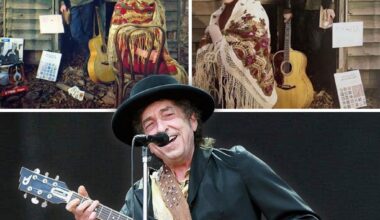Before Brian May became Queen’s iconic lead guitarist, he embarked on a remarkable DIY project with his father, Harold May, that would forever shape his sound and legacy. At just 16 years old, Brian and his dad crafted the “Red Special,” a guitar built almost entirely from household materials—an invention born out of necessity, creativity, and a deep passion for music.
The story began in August 1963 and culminated in October 1964, as the teenage May sought an instrument that matched his musical ambitions without the cost of commercial guitars, which were prohibitively expensive for his modest family. Using what they had on hand, the duo repurposed oak from an old table for the guitar’s body, combined with blockboard and finished with a mahogany marquetry veneer. The neck was fashioned from mahogany taken from a Victorian fireplace mantel, giving the guitar one of its affectionate nicknames—the “Fireplace.” The fretboard, made from oak and painted black, was adorned with custom mother-of-pearl inlays shaped from buttons.
But it wasn’t just the materials that made the Red Special special. Brian and Harold engineered unique features that pushed the boundaries of guitar design. The aluminum bridge with roller saddles reduced string friction, while the tremolo system incorporated motorbike valve springs and a knife-edge pivot—ingenious solutions that gave Brian dynamic control over his sound. Even the tremolo arm was crafted from bicycle saddlebag parts and a knitting needle tip, embodying true resourcefulness.
The guitar sports a semi-hollow body, a 24-inch scale length, and 24 frets, allowing for a wide tonal range. Brian designed it to feed back and interact with the air around him, inspired by Jeff Beck’s electrifying performances. Its controls included master volume and tone knobs, on/off slide switches for each pickup, and an in/out of phase switch—offering a rich palette of sounds that became central to Queen’s music.
More than just a tool, the Red Special symbolizes the bond between father and son and Brian’s relentless determination. Harold’s background as an electrical engineer was crucial in overcoming technical challenges, turning household junk into a masterpiece that would accompany Brian through legendary performances—from Queen’s studio albums to Live Aid and even the 2012 London Olympics closing ceremony.
The guitar’s reddish-brown hue, achieved with Rustins Plastic Coating, along with nicknames like “Old Lady,” reflect the personal affection Brian has for his lifelong companion. The Red Special’s legacy endures today through official replicas produced by Brian May Guitars, allowing fans and musicians to experience a piece of rock history.
In the end, the story of the Red Special is not just about a guitar made from scraps—it’s a testament to creativity, ingenuity, and the profound connection between an artist and his instrument. For Brian May, the Red Special was more than a project with his dad; it was the foundation of a musical journey that changed rock forever.




